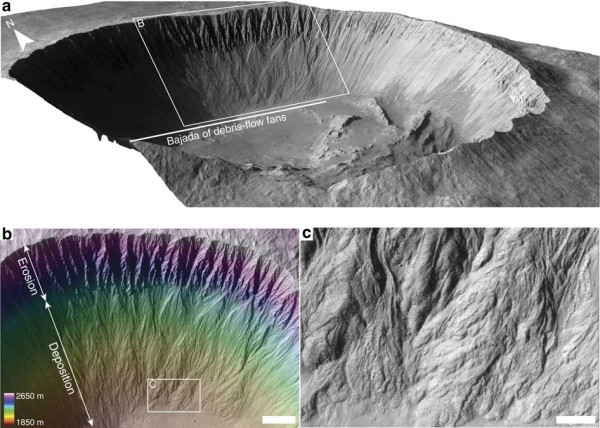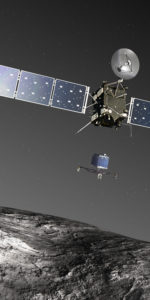
The fact that Mars used to have large amounts of liquid water on its surface is pretty much accepted among scientists, but there is still the question of how long that water lasted. How long ago was it still present? A billion years? A few million? New evidence based on data from the Mars Reconnaissance Orbiter (MRO) suggests that water was still on the surface within the past million years, perhaps even as recently as 500,000 years ago, which is indeed recent, geologically speaking.
The new study was published June 23 in the journal Nature Communications.
From the abstract:
“Liquid water is currently extremely rare on Mars, but was more abundant during periods of high obliquity in the last few millions of years. This is testified by the widespread occurrence of mid-latitude gullies: small catchment-fan systems. However, there are no direct estimates of the amount and frequency of liquid water generation during these periods. Here we determine debris-flow size, frequency and associated water volumes in Istok crater, and show that debris flows occurred at Earth-like frequencies during high-obliquity periods in the last million years on Mars. Results further imply that local accumulations of snow/ice within gullies were much more voluminous than currently predicted; melting must have yielded centimetres of liquid water in catchments; and recent aqueous activity in some mid-latitude craters was much more frequent than previously anticipated.”

The international team of researchers, led by Tjalling de Haas, a physical geographer at Utrecht University in the Netherlands, compared images taken by the HiRISE camera on MRO with mud flows on Earth and “found that running water must have existed on the Red Planet relatively recently.”
The team took into account the fact that Mars has experienced wild swings in its axial tilt over a timescale of tens to hundreds of thousands of years, since it does not have a large moon to help stabilize its orbit.
“On Earth, we have a 2 to 3-degree tilt [change] which causes ice ages and warm ages. On Mars that difference is between twenty and thirty degrees,” de Haas said.
“What we found was that sufficient quantities of water flowed on Mars’ surface to create large ‘debris flows’ at certain spots when there was a high axial tilt. Debris flows are slurries of water, mud and rock which surge downhill – on Earth they can be very hazardous and are triggered by heavy rain or volcanically melted ice or snow (also called lahars),” said Susan Conway, a Post Doctoral Research Associate at The Open University.

The researchers focused on debris flows within a crater called Istok in the southern highland planes of Mars’ Aonia Terra; hundreds of overlapping flows were found, showing that there were repeated episodes of flowing water triggering debris flows, after the crater first formed. The crater is filled with well-preserved flows and fan-shaped deposits of sediments.
MRO images of Istok from different angles were used to produce a 3-D computer model of the terrain inside the crater. When compared with debris flow deposits in the Arctic on Earth, there was a remarkable similarity. They also found that the flows appeared to occur at the same rate on both Mars and Earth.
“The pictures from HiRISE give us a great amount of detail,” said de Haas, about “25 centimeters of spacial resolution on the ground.”
It is estimated that the muddy flows were several inches deep, and required 10 times more liquid water (and snow) than predicted by the best current models of Mars’ ancient climate.
As de Hass mentioned in Popular Mechanics: “I was actually really quite surprised to discover the volume and activity of water required to explain the [gullies] and debris in the crater. The takeaway is that on a relatively recent timescale, there was quite some fluvial activity at certain locations [like the Istok crater] on Mars, at least for short periods.”
As well as Istok, similar-looking flows were found elsewhere on Mars as well, but they didn’t look as “fresh” as the Istok ones. What makes the Istok flows different?
As Conway noted: “Is there something peculiar about Istok crater which means the ‘weather’ conditions were different to the rest of Mars during the past million years? Was there another source of the water at Istok that we have overlooked – perhaps underground? For me, it is the fact that research almost always throws up such new and interesting questions that keeps drawing me back to studying Mars.”
The observations of these debris flows can also help researchers better understand the “Earth-like” glacial-interglacial cycles on Mars, which occur when the axial tilt of the planet changes. This has also happened on Earth. When there is an increase in the tilt, the ice caps will melt. Because of the thin atmosphere and low pressure, this can’t happen on Mars—instead the ice caps would likely go back into the atmosphere as water vapor and clouds, even snow. Right now, Mars is in a glacial part of the cycle, so most of the water is in the form of ice. Even so, it is interesting to note that the Mars Phoenix Lander, which landed in 2008 near the north pole, observed snowfall at higher altitudes.
The observations of these debris flows add to the ever-growing evidence for large amounts of liquid water in Mars’ past. Whether that past was warm or cold is still up for debate, but one thing is certain: It was wet.
Want to keep up-to-date with all things space? Be sure to “Like” AmericaSpace on Facebook and follow us on Twitter: @AmericaSpace
Missions » MOM » Missions » MAVEN »





One Comment
One Ping
Pingback:Muddy Mars: new evidence for liquid water flows within past million years